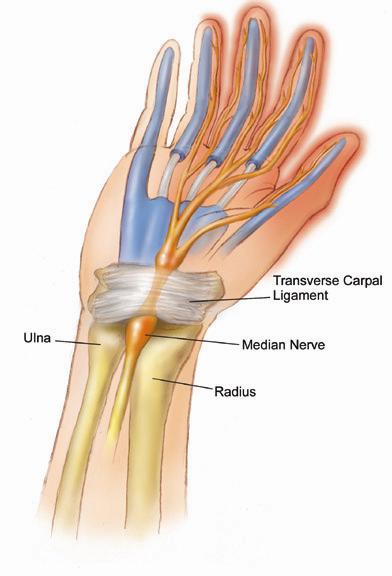Carpal Tunnel Syndrome
Carpal Tunnel Syndrome is an irritation of the Median nerve in the wrist that causes numbness, tingling, pain and weakness in the hand. It typically affects the thumb, index and middle fingers and symptoms are often worse at night. The Median nerve travels down the forearm and enters the hand after passing through the Carpal Tunnel, under the Transverse Carpal Ligament, located in the central part of the wrist.
Carpal tunnel syndrome affects about 5% of the population, is most common in middle-aged women but can affect any adult. Any condition that causes increased direct pressure on the median nerve in the wrist can lead to carpal tunnel syndrome. Many people with carpal tunnel syndrome have no identifiable cause. Carpal tunnel syndrome is diagnosed based on the complaints of the individual combined with physical tests. Often, an electrical test such as an EMG or Electromyography is used to diagnose the condition. No single test is definitive for diagnosis of carpal tunnel syndrome. Rather, the person’s complaints and test findings together lead to its diagnosis and decision to treat with surgery or therapy.
Causes
The risk factors associated with the development of carpal tunnel syndrome include the following:
• Pregnancy
• Wrist fractures
• Diabetes
• Inflammation related to Rheumatoid Arthritis and other causes
• Repetitive activity involving the hands
Signs and Symptoms
The following are symptoms associated with carpal tunnel syndrome. You may still have Carpal Tunnel Syndrome if you have only a few symptoms.
- Numbness, pain and tingling in your thumb, index, and middle fingers
- Tingling, numbness, or pain, which may radiate up your arm towards your elbow
- Hand weakness
- Dropping objects
- Difficulty feeling and handling small objects
Symptoms are usually worse at night and are sometimes temporarily relieved by shaking your hands.
Treatment
Hand Therapy can often provide relief for milder cases of Carpal Tunnel Syndrome. Cases than have gone on for many months or years or that have progressed to the point that the muscles at the bottom of the thumb have wasted may require surgery.
A conservative, or non-surgical program consists of wearing a splint to keep the wrist in a neutral position at rest for up to six weeks, depending on the frequency and intensity of the symptoms. Generally we advise against drug store splints as, if not fitted correctly, they may be ineffective or even increase the symptoms. In addition to splints, tendon and nerve gliding exercises and addressing swelling at the wrist can significantly help. Ultrasound and cold laser have, at times, demonstrated some effectiveness.
Surgery
When nonsurgical treatment has failed or for more advanced cases, surgical treatment should be considered. Generally speaking the longer the symptoms persist, the less likely of a full resolution of the symptoms. We recommend that you talk to a surgeon rather than wait many months or years. The surgery takes pressure off the nerve by releasing a ligament at wrist level. Surgery is typically done at an outpatient center. There are two commonly used approaches. The open approach and the arthroscopic approach. In the open approach the surgeon will make a small cut over the palmar side of the wrist and then release the ligament that covers the carpal tunnel. By releasing the ligament, the size of the carpal tunnel increases and pressure is relieved from the nerve in the carpal tunnel. With the arthroscopic approach the surgeon makes two smaller incisions either side of the ligament, inserts a small tool and releases the ligament. With this latter approach the scars are smaller and the recovery tends to be a little quicker. There is a slightly higher risk with the arthroscopic surgery but the long term results are the same.
Overall, surgery is very safe, however risks do exist including infection, stiffness, pain or scar sensitivity and nerve injury. Some people experience immediate relief from the symptoms once the pressure on the nerve is eliminated. For others, with more long- standing and severe pressure on the nerve, there may be a slower reduction in symptoms. Some patients with extremely severe cases may receive little or no relief.
After surgery the surgeon may refer you to a Hand Therapist. Generally this decision is based on your post operative presentation.
If you have questions about this condition or any other questions about Hand Therapy please call or email us. We would be happy to answer your questions.











